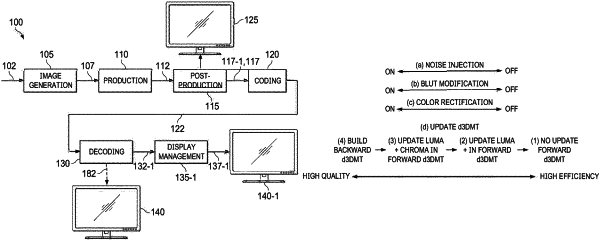| CPC H04N 19/86 (2014.11) [H04N 19/132 (2014.11); H04N 19/186 (2014.11); H04N 19/46 (2014.11)] | 14 Claims |

|
1. A method comprising:
generating a backward reshaping mapping table initially as an inverse of a forward reshaping mapping table, wherein the forward reshaping mapping table is used to generate forward reshaping mappings to generate a forward reshaped image of a first dynamic range from a source image of a second dynamic range, wherein the first dynamic range is lower than the second dynamic range, wherein the forward reshaping mapping table comprises luminance codewords of the second dynamic range and chrominance codewords of the second dynamic range of samples from the source image, and luminance codewords of the first dynamic range and chrominance codewords of the first dynamic range of corresponding samples from a reference image of the first dynamic range generated by color grading the source image, wherein the number of samples from the source image is reduced as compared to the number of pixels in the source image;
updating the backward reshaping mapping table by replacing in the backward reshaping mapping table the luminance codewords of the first dynamic range with forward reshaped luminance codewords, wherein the forward reshaped luminance codewords are generated by applying a luminance forward reshaping function to the luminance codewords of the second dynamic range, wherein the luminance forward reshaping function is constructed from the forward reshaping mapping table with cumulative density function (CDF) matching;
constructing from the luminance forward reshaping function a luminance backward reshaping function mapping luminance codewords of the first dynamic range to luminance codewords of the second dynamic range;
modifying a portion of the luminance backward reshaping function above a specific luminance codeword of the first dynamic range based on a ratio between an estimated maximum luminance range that can be represented without showing banding artifacts and an actual luminance range represented by the luminance backward reshaping function;
updating the backward reshaping mapping table by replacing in the backward reshaping mapping table the chrominance codewords of the second dynamic range with desaturated chrominance codewords, wherein the desaturated chrominance codewords are generated by applying a desaturation function to the chrominance codewords of the second dynamic range, wherein the desaturation function is constructed based on a ratio between the modified luminance backward reshaping function and the original luminance backward reshaping function;
using the backward reshaping mapping table and the luminance forward reshaping function to generate backward reshaping mappings for creating a reconstructed image of the second dynamic range from the forward reshaped image of the first dynamic range;
encoding, in a video signal, the forward reshaped image along with image metadata specifying the backward reshaping mappings.
|